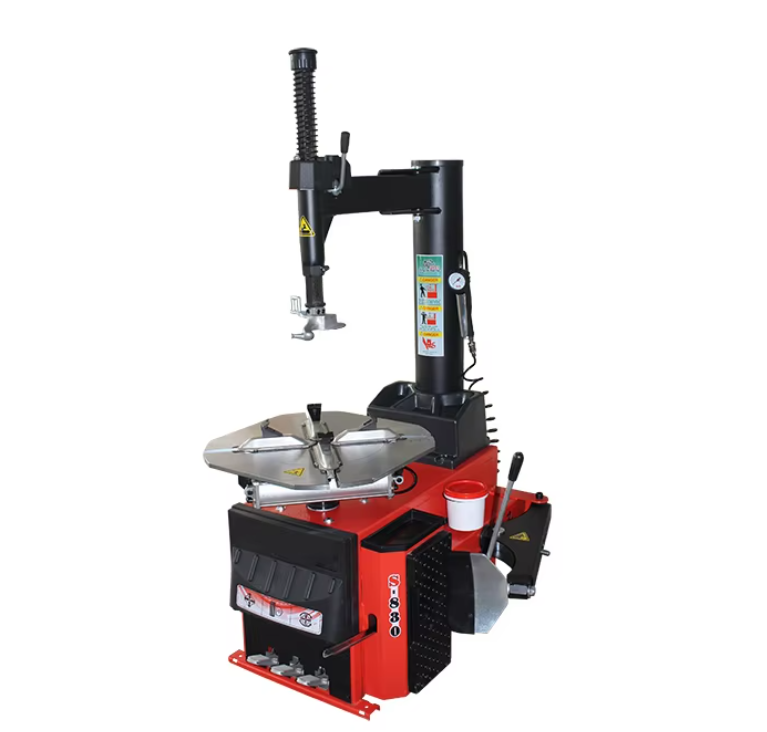Key Components of an Automatic Tire Changer
Bead Breaker Mechanism
A bead breaker makes all the difference when working with automatic tire changers, since it helps pop that stubborn tire bead off the rim much easier than trying to do it by hand. Most shops would agree that this part cuts down on labor time dramatically compared to older manual techniques where workers had to wrestle with tires for hours. These breakers typically run on either hydraulic fluid under pressure or compressed air, each system having its own advantages depending on shop needs. What's really handy though is seeing newer models come equipped with pressure adjustments so they can handle everything from skinny motorcycle tires to massive truck wheels without causing any harm to the rubber. Technicians love this flexibility because it means one machine works across multiple vehicle types while keeping things safe during service appointments.
Turntable and Clamping System
Turntables play a key role in keeping wheels stable while changing tires, which keeps everyone safe from accidents. Most shops have clamping systems that work with their turntables, and these come in two main types manual ones that need some muscle power, or automatic versions that do most of the work themselves. Some newer models even include self centering tech that makes setup quicker and reduces mistakes made by workers. For luxury cars especially, proper clamping matters a lot because damaged wheels cost thousands to replace. Mechanics know this well they've seen too many pricey rims warped or bent when improper equipment was used. Good quality clamping systems protect both the vehicle and the shop's reputation over time.
Mounting/Demounting Head
Tire changers rely heavily on good quality mounting heads to get the job done right without damaging expensive rims during installation or removal. Modern equipment comes equipped with different heads that swap out easily depending on what kind of tire needs attention, whether it's a small passenger car or something bigger like an SUV. This flexibility matters a lot for shops dealing with all sorts of vehicles coming through their doors daily. What makes these systems worth investing in though? They cut down on the time mechanics spend wrestling with stubborn tires. A technician working at a hectic garage can handle twice as many cars in the same amount of time compared to older methods. That kind of speed difference translates directly into happier customers getting their cars back faster when every minute counts.
Bead Roller and Assist Arms
Bead rollers play a crucial role in getting that tire bead properly seated during installation, which cuts down on potential leaks. What these tools basically do is apply even pressure all around the tire so it sits just right where it needs to go. Many models come equipped with those helpful assist arms too, especially useful when dealing with heavier tires or those low profile ones that tend to be a bit stubborn. Mechanics really appreciate these arms because they give that extra push needed while keeping everything stable enough to maintain proper alignment. Shops that have upgraded their equipment with such features report noticeable improvements in both workplace safety and job completion times, something that matters a lot in today's fast paced auto repair shops where customers expect quick turnarounds without compromising quality.
Step-by-Step Operation Process
Wheel Positioning and Clamping
Getting the wheel positioned right comes first when working with a tire changer, and it makes all the difference in keeping the rim intact. Both manual and automatic clamping systems work to lock things down properly so that whatever needs doing next can be done accurately. Most technicians will tell anyone who'll listen that getting this part right from the start saves headaches later on. A good setup here really sets the whole job up for success, making everything else go smoother without unexpected complications down the road.
Bead Breaking and Separation
When technicians break beads, they apply targeted pressure using the bead breaker tool, something that really matters if we want to get those stubborn tire beads away from the wheel rim. This process actually lifts the tire clear off the rim surface, making it ready for removal while keeping potential damage at bay. Getting this separation right makes all the difference when taking tires off later on. Without proper bead breaking first, there's always a risk of scratching up either the tire itself or damaging the rim during what should be a straightforward removal process.
Tire Demounting Sequence
The tire demounting sequence follows established protocols to guarantee safety and effective operation. It's imperative for operators to consistently monitor machine components to ensure all functions are performing correctly throughout this phase. Any mistakes during demounting can result in significant equipment damage or even pose injury risks to workers.
Tire Mounting and Bead Seating
When mounting tires, getting the tire properly positioned on the rim before the bead seats matters a lot. The bead needs just the right amount of air pressure to create that tight seal between tire and rim. If this step gets messed up, all sorts of problems can pop up down the road with the tire. After the tire goes on, it's important to check around for any air leaks and make sure everything looks good where the tire meets the wheel. A quick visual inspection combined with some basic pressure tests will go a long way toward keeping the whole setup safe and reliable for actual driving conditions.
Safety Features and Power-Assist Technology
Pneumatic Assist Arm Functions
Pneumatic assist arms play a big role in modern tire changing setups because they can lift and move those heavy tires around with much less effort from the techs. When dealing with bigger, heavier rubber these days, especially on trucks or SUVs, having this kind of help makes all the difference. The pneumatic system basically speeds things up while keeping everyone safe, which is something every shop owner wants. Most mechanics will tell you that trying to muscle through tire changes without proper assistance leads to back problems down the road. So shops that invest in good pneumatic equipment not only get work done faster but also protect their workforce from long term injuries.
Anti-Rebound Inflation Safety
Anti-rebound systems for tire inflation stop those dangerous explosions that can happen when inflating tires too fast, something we've all seen go wrong in workshops before. Most of these safety mechanisms comply with OSHA regulations and similar guidelines worldwide, so they're pretty much mandatory equipment nowadays. What makes them stand out is how modern versions actually integrate smart sensors and pressure monitoring tech. This doesn't just keep everyone safer from flying debris it also means mechanics get better control over inflation speeds. Shops report fewer accidents and downtime since these systems automatically shut off when pressures reach unsafe levels, which is a game changer for busy repair facilities dealing with multiple vehicles at once.
No-Mar Wheel Protection
No mar tech protects wheels against scratches and dents when changing tires. Makes all the difference for those fancy or custom wheels that cost a fortune. Without it, these expensive rims get scratched up real quick during service. Special materials are what makes this possible. Mechanics apply them to keep the wheels looking good while still working properly. Car owners who spend big bucks on premium wheels definitely want this protection during routine maintenance.
Automatic Blade Retraction
Blade retraction systems make workplaces much safer by pulling back sharp components whenever they're not needed. Without these features, technicians working on tire changers face real risks of cuts or other injuries from exposed blades. Many shops have reported fewer accidents since installing automatic retraction mechanisms. Looking at the tech behind these systems shows how far equipment safety has come in recent years. Manufacturers keep finding better ways to protect workers while still getting the job done efficiently. For mechanics who deal with heavy machinery daily, having reliable blade protection isn't just nice to have it's become essential for maintaining both safety standards and productivity levels across repair facilities nationwide.
Advantages Over Manual Tire Changing
Reduced Physical Strain for Technicians
Automatic tire changers really cut down on the physical toll taken on mechanics, which makes workplaces run smoother overall. When shops switch from old fashioned manual methods to these automatic systems, workers don't have to strain themselves so much during daily operations. This actually helps lower injury rates across the board. Mechanics report feeling happier at work too because they're not constantly battling fatigue. Research shows that tire shops adopting automation typically see around a 30% jump in productivity numbers. That means faster service times and fewer bottlenecks in busy garages. Once the machines handle the heavy lifting, technicians get to tackle more interesting problems instead of just wrestling with stubborn tires all day long.
Handling Low-Profile and Run-Flat Tires
Automatic tire changers have been built specifically for dealing with those tricky modern low profile and run flat tires that just won't budge with old school tools. These tires are constructed differently from standard ones, they're much stiffer and harder to work with, which is why regular equipment simply doesn't cut it. That's where automation comes into play. Tire shops equipped with these machines can now handle jobs that would otherwise require sending customers elsewhere. Mechanics no longer need to struggle with stubborn sidewalls or risk damaging expensive wheels during changes. The result? Shops become go to places for all sorts of vehicles, from sports cars with those ultra thin tires to SUVs with reinforced run flats. Word spreads fast when a shop can fix what others can't, bringing in new clients who might not have considered that particular service center before.
Increased Shop Throughput Efficiency
Tire shops that invest in automatic tire changers see a real boost in how many tires they can change over any given week. Faster service means happier customers who don't have to wait around for hours, plus it opens up opportunities for extra sales when time allows. Some industry reports indicate shops with these machines might actually double their work output compared to old fashioned manual methods. What does this mean practically? More cars get serviced each day, more people walk through the door, and ultimately healthier bottom lines at month end. While automation definitely streamlines operations, most shop owners will tell you there's still value in having skilled technicians on hand for complex jobs that machines just can't handle yet.
Consistent Precision in Tire Service
Automated tire changing systems deliver much better accuracy than what mechanics can typically achieve by hand, which cuts down on mistakes during service work. The improved accuracy helps tires last longer while making vehicles run smoother after they leave the shop. Shop owners report seeing fewer angry customers coming back with problems like uneven wear or improper inflation once they switch to automated equipment. People just want consistent results when it comes to something so critical for safety. Mechanics themselves often notice this too - their workload decreases because there are simply fewer repeat visits needed for fixes that should have been done right the first time. As more garages adopt these technologies, we're starting to see real improvements across the industry in terms of quality control and overall customer satisfaction rates.
FAQ
What is a bead breaker mechanism?
A bead breaker mechanism is a component in an automatic tire changer that loosens the tire bead from the wheel rim efficiently, simplifying the tire removal process.
How does a turntable and clamping system work?
A turntable securely holds the wheel in place during tire-changing operations, while clamping systems, which can be manual or automatic, ensure the wheel remains stable, minimizing human error.
What are the benefits of automatic tire changers?
Automatic tire changers reduce physical strain for technicians, handle low-profile and run-flat tires effectively, increase shop throughput efficiency, and ensure consistent precision in tire service.

